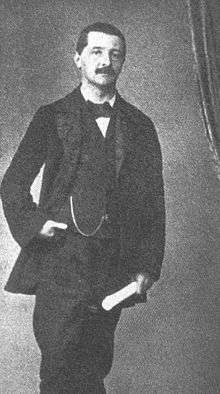Messe für den Gründonnerstag
| Messe für den Gründonnerstag | |
|---|---|
| Mass by Anton Bruckner | |
 The young Bruckner | |
| Key | F major |
| Catalogue | WAB 9 |
| Form | Missa brevis |
| Composed | 1844–1845: Kronstorf |
| Dedication | Ad maiorem Dei gloriam |
| Published | 1932: Regensburg |
| Movements | 8 (2 lost) |
| Vocal | SATB choir |
Anton Bruckner composed the Messe für den Gründonnerstag (Mass for Maundy Thursday), a Choral-Messe in F major (WAB 9) for mixed choir a cappella, in 1844 while he was a schoolteacher's assistant in Kronstorf. Bruckner dedicated the work A.M.D.G.[1][2]
The work, the manuscript of which is stored in the archive of Wels, was first published in band I, pp. 258–274 of the Göllerich/Auer biography. Thereafter, only the Gradual Christus factus est was issued by Anton Böhm & Sohn in 1931,[2] so that the work was listed by Grasberger as Christus factus est, WAB 9.
The full setting of the mass is edited in Band XXI/5 of the Gesamtausgabe.[3]
Music and text
The work is divided into six parts:
- Gradual Christus factus est, F major
- Credo, F major
- Offertory Dextera Domini, F major
- Sanctus, E-flat major
- Benedictus, G major
- Agnus Dei, D minor
Total duration: about 10 minutes.
This Missa brevis exhibits as the previous Kronstorfer Messe relationships to Palestrina's style.[4] It contained originally no Kyrie or Gloria, but included the Gradual Christus factus est and the Offertory Dextera Domini proper for the feast.[5][6][7][8]
The text of Dextera Domini is derived from Psalm 117 in the Vulgata (Psalms 118:16–17).
Dextera Domini fecit virtutem, |
The right hand of the Lord hath wrought strength; |
As also in the following Missa solemnis, Mass No. 1 and Mass No. 2 the first verse of the Credo is not composed and has to be intoned by the priest in Gregorian mode before the choir is going on. Only the first part of the Credo is composed, until "descendit de caelis".[1] The Sanctus is a slightly modified version of the Sanctus of the Kronstorfer Messe.[7][9]
The extra fugated Kyrie and Gloria, which were composed in 1845, have been lost.[1][2][10]
Use in the modern liturgy
To make the Messe für den Gründonnerstag usable for Eucharist celebration Joseph Messner revised in 1941 the existing movements, and created a Kyrie and a Gloria, by using elements of the Gradual and the Offertory, and organ accompaniment ad libitum.[8]
Discography
There is a single recording of the entire original setting of the Mass:
- Rupert Gottfried Frieberger, Anton Bruckner – Kirchenmusikalische Werke, Vokalensemble der Stiftsmusik Schlägl – Fabian Records CD 5115, c. 2005
References
- 1 2 3 C. van Zwol, p. 700
- 1 2 3 U. Harten, pp. 281-282
- ↑ Gesamtausgabe - Kleine Kirchenmusikwerke
- ↑ J. Garrat, p. 183
- ↑ R. Haas, pp. 41–42
- ↑ M. Auer, p. 59
- 1 2 J. Williamson, p. 43
- 1 2 Roelofs' critical discography of the Messe für den Gründonnerstag
- ↑ Roelofs' critical discography of the Kronstorfer Messe
- ↑ U. Harten, p. 245
Sources
- August Göllerich, Anton Bruckner. Ein Lebens- und Schaffens-Bild, c. 1922 – posthumous edited by Max Auer by G. Bosse, Regensburg, 1932
- Anton Bruckner – Sämtliche Werke, Band XXI: Kleine Kirchenmusikwerke, Musikwissenschaftlicher Verlag der Internationalen Bruckner-Gesellschaft, Hans Bauernfeind and Leopold Nowak (Editor), Vienna, 1984/2001
- Max Auer, Anton Bruckner. Sein Leben und Werk. Amalthea-Verlag, Vienna, c. 1950
- Robert Haas, Anton Bruckner, 2nd print (Reprint der Ausgabe Athenaion, Potsdam, 1934), Laaber Verlag, Regensburg, 1980. ISBN 3-9215-1841-5
- Uwe Harten, Anton Bruckner. Ein Handbuch. Residenz Verlag, Salzburg, 1996. ISBN 3-7017-1030-9.
- James Garrat, Palestrina and the German Romantic Imagination, Cambridge University Press, Cambridge, 2004. ISBN 0-521-80737-9
- John Williamson, The Cambridge Companion to Bruckner, Cambridge University Press, Cambridge, 2004. ISBN 0-521-80404-3
- Cornelis van Zwol, Anton Bruckner – Leven en Werken, Uit. Thot, Bussum, NL, 2012. ISBN 978-90-6868-590-9
External links
- Messe für den Gründonnerstag, WAB 9: Scores at the International Music Score Library Project
- Choralmesse / Messe für den Gründonnerstag Christus factus est, F-Dur, WAB 9 Critical discography by Hans Roelofs (German)
- Smaller sacred works (1835–1892) Gesamtausgabe – Volume XXI
- Live performances can be heard on YouTube:
- Christus factus est by the Choir Exultate (2009)
- Dextera Domini by Oligotett Con So Nett (2009)
- Sanctus & Benedictus and Agnus Dei by the Cantores Carmeli, Linz (2011)